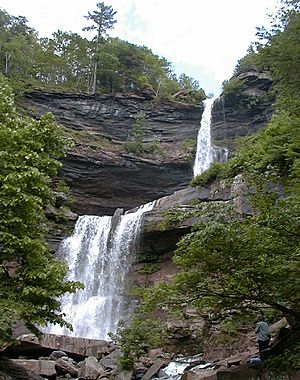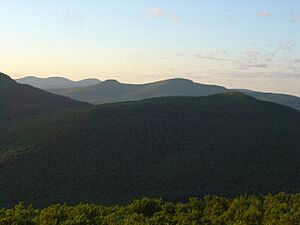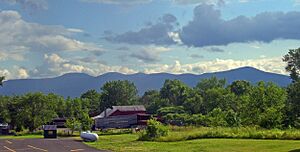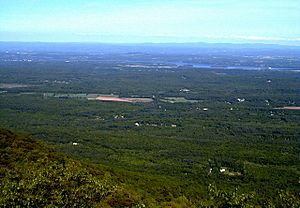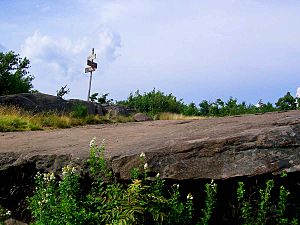Catskill Escarpment facts for kids
Quick facts for kids Catskill Escarpment |
|
|---|---|
| Great Wall of Manitou | |

The Escarpment as seen from Olana State Historic Site, across the Hudson River
|
|
| Highest point | |
| Peak | Blackhead Mountain (Windham/Jewett/Cairo) |
| Elevation | 3,940 ft (1,200 m) |
| Geography | |
| Country | United States |
| Parent range | Catskill Mountains |
| Biome | temperate hardwood forest, boreal forest |
| Geology | |
| Orogeny | Acadian |
| Age of rock | Silurian and Devonian |
| Type of rock | Shale and sandstone |
The Catskill Escarpment is a dramatic mountain range in the northeastern part of the Catskill Mountains in New York State. People often call it simply "the Escarpment" or the "Great Wall of Manitou." For geologists, it's known as the "Catskill Front." This mountain range rises very steeply from the Hudson Valley, with some peaks reaching over 3,000 feet (914 meters) high. It includes three of the highest peaks in the Catskills, and there are almost no smaller hills leading up to it.
This area was the first part of the Catskills to attract attention from early European settlers. A botanist named John Bartram wrote about his trips here before the American Revolution. About a century later, the North-South Lake area became home to fancy resorts like the Catskill Mountain House. The amazing views of the Escarpment also inspired Thomas Cole and other artists of the Hudson River School, which was the first art movement in the United States. Today, much of the Escarpment is protected as Forest Preserve within the Catskill Park. It's a popular spot for hiking, camping, and other outdoor activities.
Contents
Exploring the Catskill Escarpment's Geography
The Catskill Escarpment starts in the south at Overlook Mountain, which is about 3,140 feet (957 meters) tall. This mountain is just north of Woodstock. A popular trail leads to its summit, where a fire tower offers amazing 360-degree views.
Mountains and Deep Valleys
Moving north from Overlook, you'll find Plattekill Mountain, about 3,100 feet (945 meters) high. It's next to the taller Indian Head Mountain. North of Plattekill, the ridge is broken by a deep, narrow valley called Platte Clove. This is the first of three major breaks in the Escarpment. Just north of Platte Clove, the range crosses into Greene County.
The mountains quickly rise again to a high area around Kaaterskill High Peak, which is about 3,655 feet (1,114 meters) tall. This is the easternmost of the Catskill High Peaks and the first of three along the Escarpment. North of it, the Escarpment is again broken by Kaaterskill Clove, the largest of its three breaks. NY 23A goes through this clove to towns like Haines Falls and Hunter. On the northern side of the clove is Kaaterskill Falls, a very old and popular tourist spot in the Catskills.
Above Kaaterskill Clove is South Mountain. The ridge then flattens out to North-South Lake, which used to be home to the famous Catskill Mountain House and other resorts. Today, it's a busy public campground. North of the lake, the ridge rises again to North Mountain, about 3,180 feet (970 meters) high. The open views from North Point, to its south, make it one of the most popular hikes in the Catskills.
Northern Peaks and Views
Beyond North Point, the Escarpment turns northwest. The land dips slightly, then rises again to Stoppel Point, which is 3,420 feet (1,042 meters) high. After this, the Escarpment is broken by Dutcher or East Kill Notch, which is now an old road used as a hiking trail. Another steep climb leads to a ridge unofficially called Arizona because it's very dry.
North of this, you'll find Blackhead Mountain, the highest point along the Escarpment at 3,940 feet (1,201 meters). It's the fifth highest peak in the entire Catskills. Its summit and nearby peaks can be seen from as far north as Albany. After its steep northern slope, the range curves sharply to the west. Smaller peaks like Burnt Knob and Acra Point form the northern wall of Big Hollow, along with Windham High Peak. At 3,523 feet (1,074 meters), Windham High Peak is the last of the three High Peaks along the Escarpment and is usually considered its northern end.
Water and Boundaries
All the water from the Escarpment eventually flows into the Hudson River. To the east, Plattekill and Kaaterskill creeks drain the cloves. To the west, most of the water feeds the beginnings of Schoharie Creek. This creek's water is important for New York City's water supply because it flows into the Schoharie Reservoir.
The Escarpment is unique because it's the only place in the Catskills where the mountain range's edge is very clear. In other directions, the mountains gradually blend into the surrounding hills, making it hard to tell where they begin or end.
Because it's so tall and steep, the Escarpment can be seen from far away. You can see it from the New York State Thruway and the Hudson River, and even from mountains in western Connecticut and Massachusetts. From the Escarpment itself, on a clear day, you can see all those areas, plus Vermont. There's even a spot along Route 23 called Five State Lookout, where you can also see New Hampshire's White Mountains.
The lower slopes of the Escarpment form part of the border between Ulster and Greene counties. Within Greene County, it separates lowland towns like Catskill from mountain towns like Hunter and Windham. The Catskill Park's boundary also follows parts of the Escarpment's slopes.
How the Escarpment Was Formed
The Catskill Escarpment was shaped over millions of years by different geological events. Two main processes created the range we see today.
Ancient Seas and Mountains
About 400 million years ago, during the Silurian period, the Catskill region was a river delta flowing into a shallow sea. Rivers carried eroded material from the Taconic Mountains, which were once as tall as 15,000 feet (4,572 meters). Later, during the Acadian orogeny (a mountain-building event), the sea became deeper. Sand and clay from newer mountains settled, forming the shale and sandstone found throughout the Catskills today.
Eventually, the seafloor began to rise. The area of today's Escarpment had the thickest layers of Devonian sediments, causing it to uplift as a whole block, forming a plateau instead of breaking into many separate mountains. Over time, the top layers of this plateau eroded, creating stream basins that eventually became today's mountains and valleys.
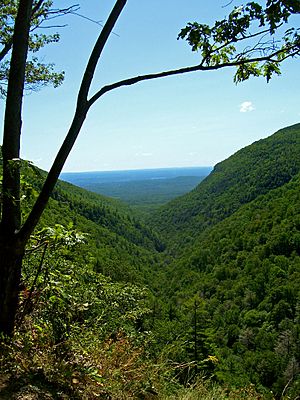
The Power of Glaciers
The Escarpment used to have gentler slopes, with lots of loose rock. But between 100,000 and 300,000 years ago, the Illinoian glaciation (a period when glaciers covered the land) swept through the region. This had two big effects:
- The glaciers scraped and steepened the slopes, leaving behind the bare cliffs we see today.
- They carved out Platte and Kaaterskill cloves from smaller, shallower valleys. In Kaaterskill Clove, the gouge was so deep that water from North-South Lake (which was supposed to flow into Schoharie Creek) instead flowed down into the new gorge. This created Kaaterskill Falls, a famous waterfall, and changed where the Schoharie Creek began.
After the glaciers melted away, the Escarpment's forests started to grow back. But because of its exposed location, lightning often caused forest fires. Historians believe the southern Escarpment has burned many times over thousands of years.
A Look at Human History on the Escarpment
The early history of the Escarpment is closely tied to the history of the Catskills itself. For a long time, the Escarpment was the most visible part of the Catskills.
Native Americans and Early Settlers
The Munsee and Mahican Native American tribes lived in the Hudson Valley below the Escarpment. They didn't live in the mountains but would go up to hunt or start fires to manage hunting grounds. While we don't have many records from early European contact, it's likely the mountains were important in their spiritual beliefs.
In 1609, Henry Hudson's ship, the Half Moon, sailed up the river that now bears his name. His sailors were the first Europeans to see the Escarpment. It wasn't until 1708 that Johannes Hardenbergh received a huge land grant of 2 million acres (810,000 hectares) that included the Escarpment. However, problems with the land grant and legal disputes made it difficult to explore or settle the area for many years.

Things started to change in 1741 when John Bartram, an early American naturalist, climbed up to a "shady vale" around North-South Lake. He collected plant samples for his English patron. He returned later and, despite being ill, became the first person to record a visit to Kaaterskill Falls. His detailed report, "To ye Cats Kill Mountains with Billy," was the first scientific account of the Catskills.
The 19th Century and Art
After the American Revolution, wealthy families like the Livingston family on the Hudson's eastern shore enjoyed amazing views of the Escarpment. They designed their estates to highlight these views. Historian Alf Evers noted that the view from these houses was "equal in almost every respect to the already famous ones admired by so many tourists to England's Lake District."
Washington Irving visited the Livingston estates in 1812, and this view may have inspired his famous story "Rip Van Winkle." Other writers also noticed the Catskills. In James Fenimore Cooper's 1823 novel The Pioneers, the character Natty Bumppo describes Kaaterskill Falls and the Pine Orchard area (where Bartram had explored):
... the place I mean is next to the river, where one of the ridges juts out a little from the rest, and where the rocks fall for the best part of a thousand feet so much up and down that a man standing on their edges is fool enough to think he can jump from top to bottom.
"What see you when you get there ? " asked Edwards.
"Creation!" said Natty, dropping the end of his rod into the water, and sweeping one hand around him in a circle, "all creation, lad."
In the same year, a hotel was built at that spot, which later became the famous Catskill Mountain House. In 1824, the Hunter Turnpike (now Route 23A) was cut through Kaaterskill Clove, making the area easier to reach.
The Escarpment became a perfect subject for a young painter named Thomas Cole. He visited the Catskills in 1825 and stayed at the new hotel. He was amazed by the wildness and beauty. His landscape paintings of the Catskills caused a sensation in New York. Other artists like Asher Durand and Frederick Church followed Cole. Their paintings, known as the Hudson River School, became the first important art movement in the United States.
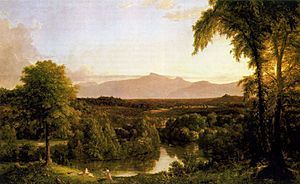
The Era of Grand Hotels
Poet William Cullen Bryant also helped make the Catskills a popular tourist spot. Steamboats and later railroads made it even easier to get there from New York City. In 1846, Charles Beach took over the struggling Catskill Mountain House and turned it into one of America's most exclusive resorts. Presidents and other important people visited. Guests explored the area, using trails that still exist today, to see Kaaterskill Falls and other scenic places.
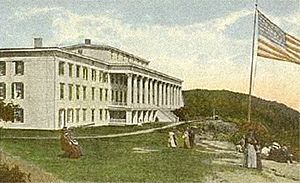
Other hotels opened nearby, like the Kaaterskill Hotel and the Laurel House near Kaaterskill Falls. However, by the 1880s, these hotels started to lose their popularity. In 1879, a geology professor named Arnold Henry Guyot announced that Slide Mountain was the highest peak in the Catskills, not Kaaterskill High Peak on the Escarpment. This news, along with other changes, affected the hotels.
In 1885, the state legislature created the Forest Preserve to protect state lands in certain counties, including the Catskills. This meant these lands had to be kept "forever wild." This didn't immediately affect the hotels, but other trends did. Wealthy guests started going to their own private camps in the Adirondacks or other mountain regions. The Catskill Mountain House built an incline railway in 1892 to bring guests up the Escarpment, but it was expensive.
The 20th Century and Public Lands
The state began buying significant land along the Escarpment in 1900. Charles Beach, the owner of the Mountain House, died in 1902. Roads were paved for cars, making it easier for guests to reach newer resorts deeper in the mountains. The Mountain House continued to struggle, and its incline railroad closed in 1918. When the Hotel Kaaterskill burned down in 1924, it was not rebuilt.
The state continued to acquire land, including Stoppel Point and most of Overlook Mountain. By the end of the 1920s, the state owned much of the Escarpment. The Mountain House struggled through the Great Depression and closed for good in 1942. Another attempt to build a hotel on Overlook Mountain was abandoned during World War II.
After the war, there were efforts to save the Mountain House, but the building was falling apart. In 1962, the state acquired the building and burned it down the next year for safety reasons. Only its stone gateposts remain. The Laurel House was also demolished.
The Escarpment changed from a private resort area to a public playground. The state developed North-South Lake into a busy campground and created new hiking trails. Today, most of the Escarpment is part of the Forest Preserve and is managed for public enjoyment.
Nature and Wildlife of the Escarpment
The forests of the Escarpment show its history, location, and shape. When the glaciers retreated, they scraped the rock, especially on the ridgetops and northern and eastern slopes. This made it hard for plants to grow on these steep, exposed areas. Because of this, you'll find many coniferous evergreen trees like red spruce and balsam fir here. These trees are usually found in boreal forests (cold, northern forests) and appear at lower elevations on the Escarpment than elsewhere in the Catskills. For example, the summit of North Mountain, at 3,180 feet (970 meters), is covered in boreal forest, which is the lowest Catskill summit to have this type of forest.
At lower elevations, many fires have led to a mixed forest where oak and pine trees are common. Some large areas of Norway spruce were planted on the north slopes of Windham High Peak in the 1930s to help regrow the forests. Because of past fires and logging, there are very few areas of first-growth (original, untouched) forest left, except for some boreal plots. The largest first-growth hardwood forest is around the summit of Windham High Peak. The eastern hemlock trees around Spruce Creek below Kaaterskill Falls are also an untouched stand. They survived because the steep terrain made it too difficult to cut them down for their bark, which was used for tanning. These ravines also have some rare plant species in New York State, like roseroot stonecrop and fragrant cliff fern.
The animals you'll find on the Escarpment are similar to those found elsewhere in the Catskills. These include white-tailed deer, porcupine, fisher, black bear, and snowshoe hare. There have also been rare sightings of bobcats on the ridge. Bird species like the rare Bicknell's thrush and ruffed grouse nest in the boreal forests. A few timber rattlesnake dens are known to exist on the rocky ledges of Overlook Mountain. Because there isn't much water on the ridgetops, there are few major fish or amphibian species, except around North-South Lake.
Protected Areas for Everyone to Enjoy
Most of the Escarpment, including all its mountaintops and ridges, has been bought by the state and added to the Forest Preserve. This means it must be kept "forever wild." Private land is only found in the cloves, and some of that is also protected. The state Department of Environmental Conservation (DEC) manages these Forest Preserve lands.
Here are some of the protected areas from north to south:
- Overlook Turnpike Primitive Bicycle Corridor: This is a road up Overlook Mountain and past Plattekill Mountain, now used for hiking and biking.
- Overlook Mountain Wild Forest: About 590 acres (239 hectares) around the road up Overlook and its summit.
- Indian Head Wilderness Area: The eastern part of this wilderness area includes the Devil's Path on the Escarpment. It also has Echo Lake, the only important body of water in a Catskill wilderness area.
- Platte Clove Preserve: A 288-acre (117-hectare) area owned by the Catskill Center for Conservation and Development at the head of the clove. It's the only privately owned protected area on the Escarpment.
- Kaaterskill Wild Forest: This 8,550-acre (3,460-hectare) area includes all the state land on Kaaterskill High Peak, and the Kaaterskill Clove and South Mountain areas, including Kaaterskill Falls.
- North Lake-South Lake State Campground: This 1,100-acre (445-hectare) area, once home to the Mountain House, is the most visited part of the Escarpment, with over two hundred campsites.
- Windham-Blackhead Range Wilderness: This large 17,100-acre (6,920-hectare) area surrounds the Big Hollow Valley and includes the Escarpment from North Point to past Windham High Peak.
- Colgate Lake/Dutcher Notch Primitive Bicycle Corridor: This 2.4-mile (3.9 km) old road goes from the lake through the notch and down the east side of the Escarpment.
- Elm Ridge Wild Forest: This 1,355-acre (548-hectare) area is at the north end of the Escarpment within the Catskill Park.
Fun Activities on the Escarpment
All the public lands on the Escarpment are great for outdoor activities like hiking, camping, and birding. Hunting and fishing are allowed during their seasons and according to state rules. You can also use unpowered boats on Echo and North-South lakes.
It's free to use most areas, except for North-South Lake Public Campground, which charges a small fee per vehicle during peak season. This fee helps provide more services for visitors. There's also a 12-mile (19 km) snowmobile loop trail around Kaaterskill High Peak and Round Top.
Hiking Trails for All Levels
The Escarpment has many hiking trails. The most important is the 22.3-mile (35.9 km) Escarpment Trail. It starts near the campground and goes north to Route 23, climbing over Stoppel Point, Blackhead, and Windham High Peak. Most of this trail is also part of the Long Path, a long-distance trail that goes through Kaaterskill High Peak and down Kaaterskill Clove. Backpackers can start near Woodstock and hike the entire Escarpment, connecting to the Long Path.
Other trails climb the ridge, mostly from the west, except for the Dutcher Notch Trail. These trails mainly lead to the Escarpment Trail. There are also shorter trails around the old Mountain House property at North-South Lake, which connect the campground to different parts of the Escarpment Trail. The most popular trail in the entire Catskills is the short path up to Kaaterskill Falls from Route 23A.
